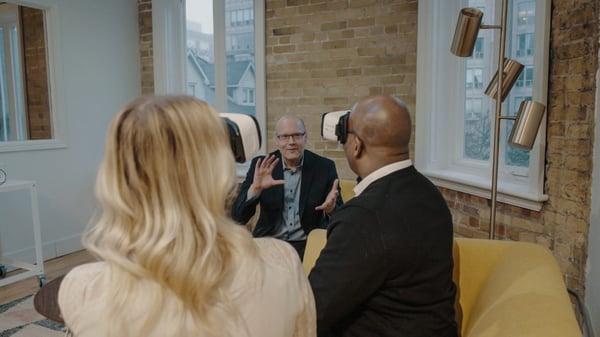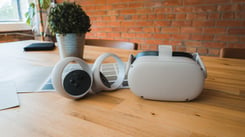The past few years have welcomed a brand new wave of VR. 2016 was the start of mass widespread VR adoption, inspiring businesses to embrace the new tech and all that it offers them. Many F500 companies have turned to VR as a business solution, enhancing the efficiency and quality of their training programs and their marketing strategies. With the current trends in business and technology, a majority of consumers are expecting VR to be a part of their daily lives. From real estate to retail, VR has proven that it is a valuable business tool for all industries, fully capable of helping you achieve your goals.
Although there are many reasons why VR is a great business solution, at the end of the day, it can still seem like a really daunting piece of technology. We understand the skepticism, and it’s difficult to feel confident using what seems to be a useful tool when you aren’t all too familiar with it.
So what even is VR?
VR = Visual Storytelling
To put it simply, VR is a presentation tool that allows you the freedom and flexibility to tell your story. Any industry who is in the business of using visual storytelling can benefit greatly from using VR to do so. Whether it be showcasing a space you have curated for your client, to a potential workplace filled with your line of products, VR literally brings your concept to life and gives everyone the chance to step into your vision.
“[VR] is the first real massive leap forward in visual storytelling”
Ian Hall, CPO of Yulio Technologies (Retrieved from here)

How Can You Use VR in Furniture?
The furniture industry, like those of A&D, rely heavily on visual storytelling, leading their clients to believe and invest in the concept painted. Besides giving the “wow” factor to a project, VR is a practical tool ridding many obstacles furniture dealers may face when trying to make a sell.
1. Say Goodbye to Translation Errors
As a furniture dealer, it can be a disappointing feeling when your clients say “I’m just not seeing it”. Sure it’s discouraging because they aren’t sold on what you’re selling them, but more importantly, there could have been a miscommunication of your vision. However, with using VR, there will no longer be a situation where your client cannot visualize your concept.
VR is the first medium to create a perfect understanding between the author and viewer, discouraging the possibility for any translation errors -- what you are seeing will be exactly what they will see. Instead of showing your clients a floorplan of a room, or a possible configuration on paper or with samples, allow them to stand in your showroom and witness your vision. Not only will it be a more stimulating and memorable experience, but you can rest assured that what you envisioned for a space will be perfectly represented.
2. Showcase Your Products in Their Space in a Whole New Way
One of the many beauties of VR is the flexibility of showcasing a space that doesn’t exist yet. The gaming industry has masterfully utilized this awesome feature, immersing their audience into a whole other universe by providing an out-of-this-world experience. This same line of thinking can be applied to those in the commercial and office furniture business.
Access your virtual portfolio, and allow your clients to experience for themselves what your products would look like in their space. Using VR in furniture gives an individual the opportunity to get as close to “trying before buying” they will ever get. Immerse your clients, and give them the chance to get acquainted with your products and what you have envisioned for them. Furthering the point on flexibility, get your clients excited about the upcoming products that you will be releasing soon. Give an exciting and unforgettable sneak peek of what your newest design will look like.
3. Build an Emotional Connection
We use our senses to navigate the world we live in, and they have an integral role in emotional processing. As such, we humans build a lot of emotional associations towards certain events or objects. By translating the input we receive, we then interpret the emotional response along with the data. For example, if I hear the squeak of a rusty chair and I find it annoying or offputting, I’m less likely to use the said chair in the future. On the flip side, if I enjoy the sleekness construction of a certain sliding door, it sparks a positive response which increases how memorable the object was, and the likeliness of greater curiosity of the product.
This is definitely an area where using VR in the furniture industry can strengthen the connection.
Although logic plays a role when we make decisions, we frequently underestimate how big of a role emotions play in the process as well. By completely immersing your clients, they are now able to see as clear as day what your vision for their space can be like. VR, being a storytelling tool, gives you the freedom to simultaneously express what you would like your client to know about a particular piece and share your story. With the most realistic visual input aside from seeing it in person, VR nurtures an emotional connection between your concept and your client, giving the potential to establish a successful long-term business relationship, and for opportunities to increase commercial/office furniture sales.
4. Become More Strategic with your Resources
Building a variety of samples in different shades and colors takes time and resources, not to mention different variations of configurations in a space. What it takes to have a variety of options to show your clients can be costly, and those resources could be better allocated elsewhere.
With using VR in furniture, you have the ability to extensively build your portfolio, and easily bring it around at the convenience of your phone. Nowadays, it’s essentially the norm to carry a smartphone that has more technologically advanced capabilities than we could ever imagine. The ability to show your clients your vision in VR is easier than ever since many VR apps have gone mobile. All you need to do is open the app, slip on an inexpensive VR headpiece, and voilà! You have a portable portfolio, ready for all occasions to showcase your designs to your clients. Start carrying around your virtual showrooms to offer an extensive selection without burning a wider hole in your pocket.
5. Speed Up Your Sales Cycle
We understand that many variables and barriers arise in each sale and that the cycle can be a long and strenuous process. Clients may have a long list of questions or concerns about a certain product, and it can become time-consuming addressing each and every one of them. However, VR applications are powerful tools that you can use to help shorten that time up and get to “sold” quicker.
Here at Yulio, one of our most popular features are our variety of hotspots, allowing you to share information right within your VR presentation. Hotspots are there to enhance your project, and span from creating a more immersive ambiance, to providing specs of a product all in one place. Showcase your forward thinking to your clients by anticipating what their concerns may be, and addressing them whilst they are still in VR. Not only does this add to the overall experience, but it quickly answers any other questions your client may have that could hold up the sales cycle. Attract your clients and future potential clients to your dealership by providing an extra layer of customer service.
It’s safe to say that many features of VR will benefit furniture dealers and manufacturers, and it’s time to prepare for the future of this business. As the future continues to encroach upon us, important to continually stay relevant, and to hunger for bigger and more exciting change. We understand that it still may be daunting, but you will never know unless you have tried it out for yourself.
Here at Yulio, we strive for excellence in performance and integrity when it comes to our product, and customer service. To learn more about how VR can enhance your business workflow, sign up for our FREE 5-day email course. To try our program for yourself, sign up for our free 30-day trial (no strings attached).


.jpg?width=245&height=150&name=active-adult-beautiful-1799244%20(1).jpg)

.jpg?width=245&height=150&name=iStock_88161583_XLARGE%20(1).jpg)

